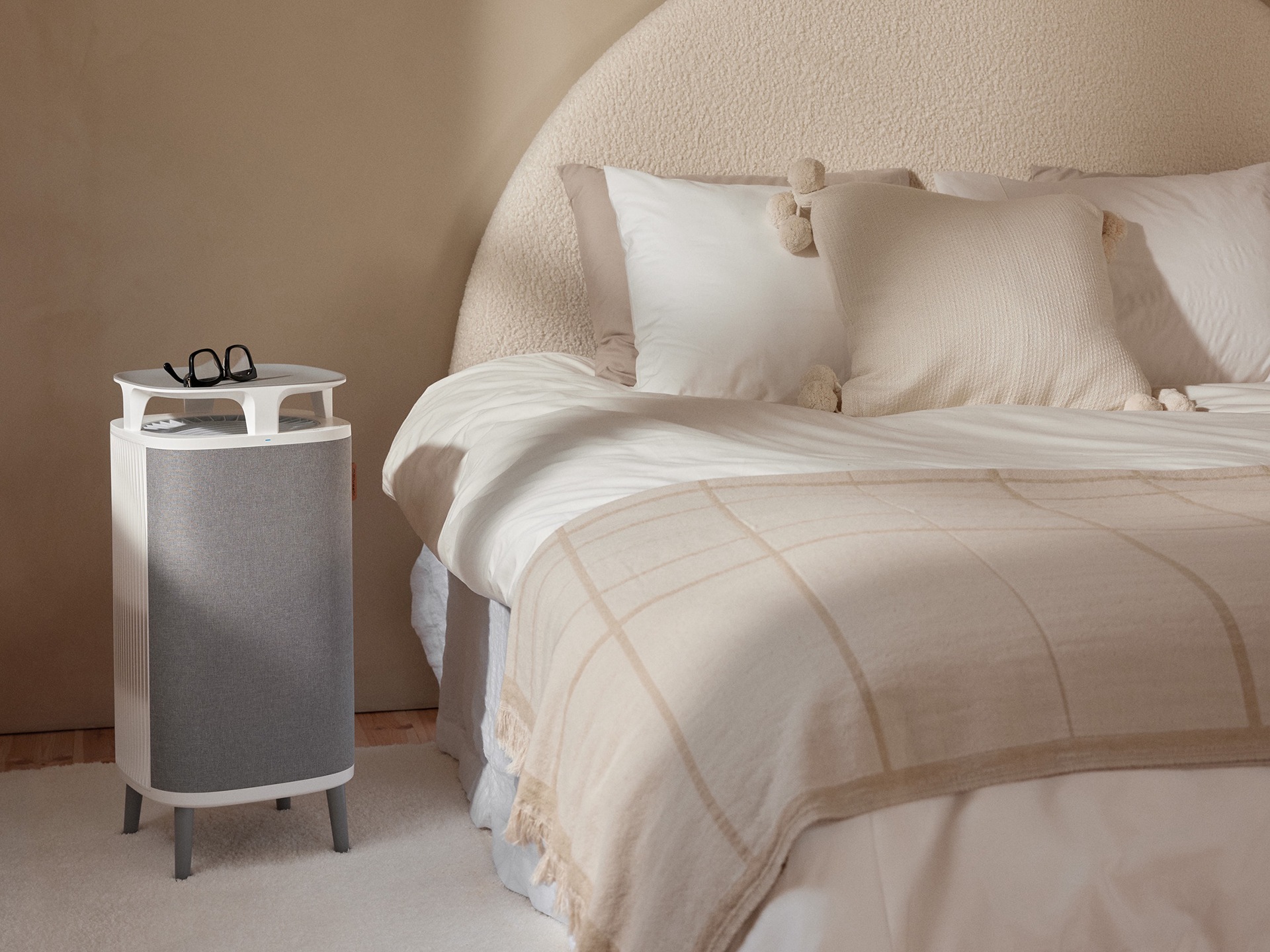Indoor air quality: why it matters and how you can improve it
The air we breathe at home is often more polluted than that outside, but we've got everything you need to know to improve your air quality at home
The quality of the air outdoors is something we have long been concerned about. Since the bad old days of London’s infamous ‘Pea Soup’ fogs and the Great Smog of 1952, various Clean Air Acts have gone a long way to improve outdoor air quality.
Legislation has established smoke control areas in built-up areas, where only smokeless fuels can be burned, and banned the discharge of dark smoke from factory chimneys. There’s still room for improvement, especially when it comes to pollution created by cars, but pollution levels have dropped significantly in the last half century, and attention is now turning to indoor air quality.

Image credit: Pexels/Pixabay
Increasingly, scientists have become concerned about the quality of the air we breathe indoors, where we actually spend about 90% of our time. In 2022 (when you might perhaps have imagined he would have had other things to think about) Sir Chris Whitty, England’s Chief Medical Officer, dedicated his annual report to the topic of air pollution. He said, “Indoor air pollution is becoming an increasing proportion of the problem as improvements in outdoor air pollution occur. Most of our days are spent indoors whether for work, study, or leisure, yet indoor air quality has been studied much less than outdoors…. A better understanding of how we can prevent and reduce indoor air pollution should now be a priority.”
Lars Dunberger, from Blueair air purifiers, says, “Studies[1] show a correlation between higher levels of PM2.5 particulates and air pollution and the increased number of people suffering from skin problems such as pigment spots and wrinkles[2], hives[3] and eczema[4].
“Polluted indoor air can also affect your sleep. Clean air helps to promote deep sleep, and people who live in areas with higher levels of air pollution are 60% more likely to sleep poorly than those living in areas with cleaner air.[5] Repeated exposure to poor indoor air quality – especially in an enclosed space with poor ventilation – can bring on headaches, fatigue, dermatitis, and more – many of the same symptoms often used to diagnose Sick Building Syndrome.”
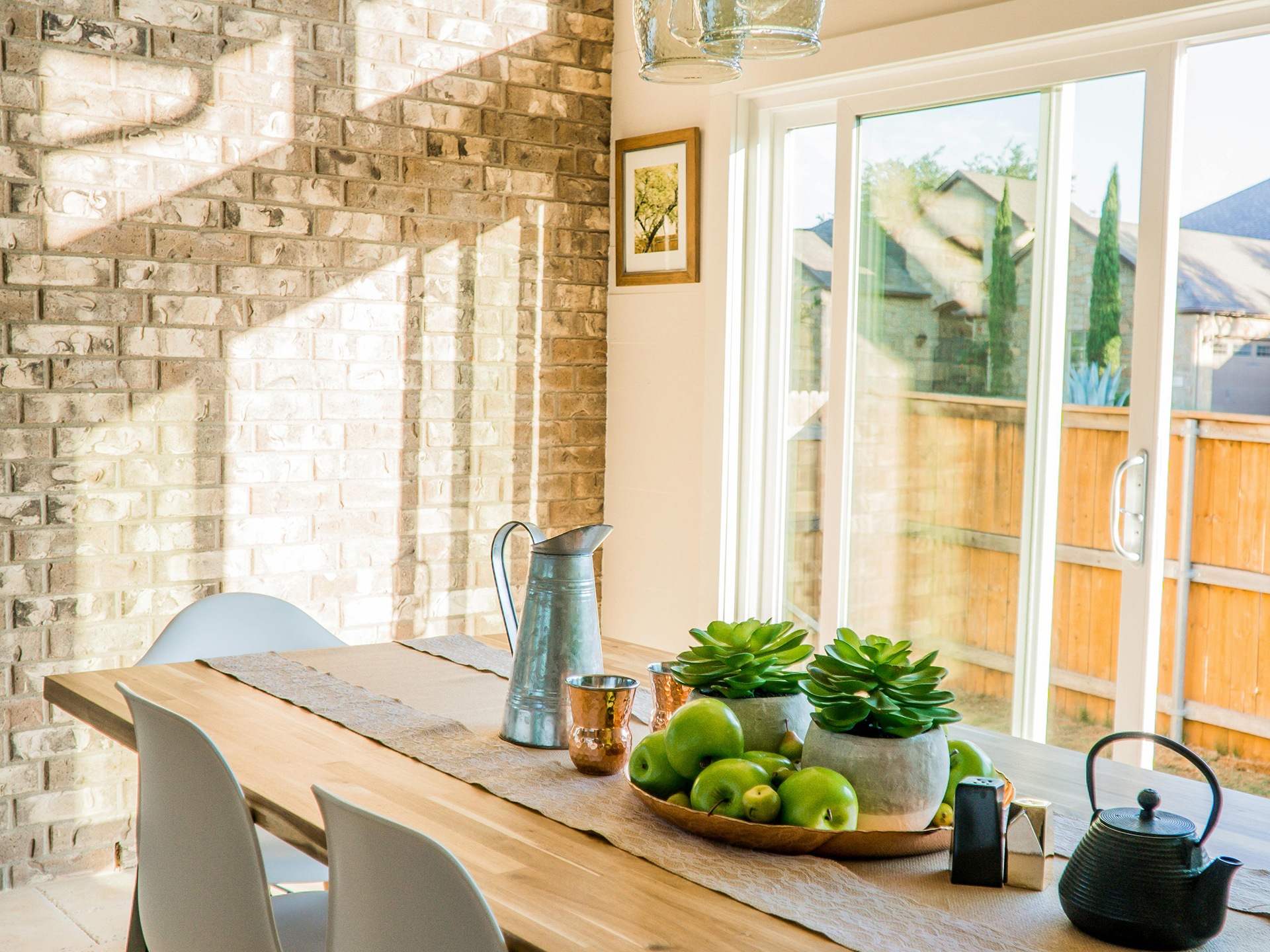
Image credit: Pexels/Mark
What are the issues?
It’s what’s in the air that causes problems, and environmental issues are generally caused by the following:
- Volatile organic compounds (VOCs): gases produced by household chemicals and products such as new flooring and furniture. Found in higher concentrations indoors than outside, they are implicated in a whole range of health issues
- Other unpleasant gases, such as nitrogen dioxide: Typically produced when you cook with gas
- Carbon dioxide: If levels in an enclosed space rise too high, this can affect your ability to concentrate
- Particulate matter: Small particles in the air, which are caused by a variety of sources, including cooking, using candles, household cleaning products and dust.
- Humidity: If the humidity levels are wrong, you can get issues with mould and dust mites.
- Radon: A naturally occurring radioactive gas that is a problem in some parts of the country.
These issues can be all exacerbated by our more airtight, better-insulated modern homes. So let’s take a closer look at some of the issues and how to tackle them.
Volatile organic compounds
VOCs are potentially hazardous gases given off by certain household products including paint and some cleaning products, as well as some types of new furniture and flooring. They can be particularly harmful to children, people with asthma and others with respiratory conditions. And, in large concentrations, they can be harmful to all of us. They also combine to form other unpleasant gases such as formaldehyde and ozone.
Many manufacturers are working hard to reduce the VOCs in their products, so it is now possible to buy everything from paint to laminate flooring that gives off far fewer VOCs. Look out for products labelled “trace VOCs”, “minimal VOCs” or “low emissions”.
There’s a list of common VOCs, their effects, potential harms, and guidelines for maximum exposure levels in the government’s Indoor Air Quality Guidelines for selected Volatile Organic Compounds (VOCs) in the UK document. This gives maximum suggested short- and long-term exposure levels for 11 different VOCs in micrograms per cubic metre. This is a useful starting point for improving the nation’s indoor air quality, but it is very hard as an individual to understand what these levels mean in practical terms our own homes. So, the advice must be to err on the side of caution and reduce your exposure to VOCs when you can.
Clean smarter
Many traditional cleaning products contain VOCs. Luckily there are low-VOC cleaning products available. But just because products are marketed as eco-friendly doesn’t necessarily mean they will be free of VOCs. Ecover’s Zero range and Delphis Eco are good ones to check out. Read the labels and look at what each product contains. Open the window when cleaning, clean when there’s noone else around, and don’t mix cleaning products.
How you clean is as important as what you clean with when it come to another aspect of indoor air quality: dealing with dust mites.
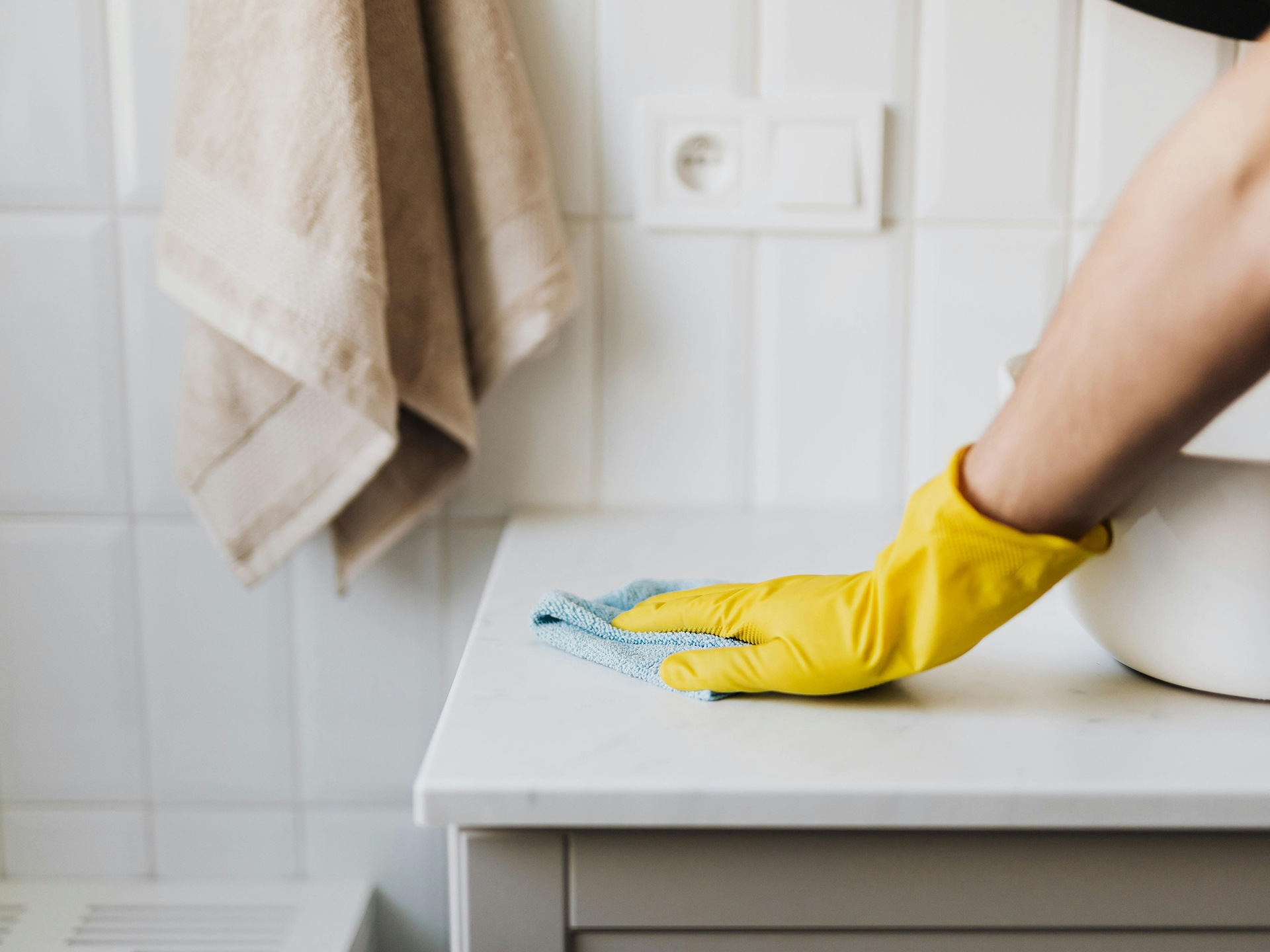
Image credit: Pexels/Karolina Grabowska
Dust mites
Dust mites are microscopic bugs that feed on shed human skin in beds, bedding and soft furnishings. Every home has them. The mites and their droppings can trigger asthma in people who are allergic to them and in children. Here’s what helps:
- damp dusting avoids stirring up dust
- hoovering frequently using a bagged vacuum with HEPA filters
- cleaning rugs and soft furnishings frequently
- washing all bedding at 60°C once a week
- keeping humidity levels between 40% to 60% (see below)
- changing the filters in air filters and mechanical ventilation systems regularly
All the other measures we’re talking here about to improve ventilation will help too.
Nitrogen dioxide
Nitrogen dioxide (NO2) is produced when fossil fuels burn. Emitted by vehicles, it is one of the pollutants measured to track outdoor air quality. According to Defra, “Short-term exposure to concentrations of NO2 can cause inflammation of the airways and increase susceptibility to respiratory infections and to allergens. NO2 can exacerbate the symptoms of those already suffering from lung or heart conditions.” NO2 also combines with VOCs to make ground-level ozone, another air-quality nasty.

Image credit: Pexels/RDNE Stock Projct
NO2 is produced when we cook with gas, which is one reason why some people are beginning to question the safety of gas hobs. Gas hobs also produce carbon monoxide and carbon dioxide, and can even leak methane and benzene when they are off.
It therefore makes sense to keep your kitchen well ventilated when you are using your gas cooker, to switch on your cooker hood every time you use the cooker and, if you’re getting a new appliance, consider swapping over to an electric induction hob. Find out the full facts on this controversial subject in our piece about gas hob safety.
Carbon dioxide
Gas cookers aren’t the only source of carbon dioxide in the home. We ourselves are, of course, a source of this potential indoor pollutant every time we exhale. Too much carbon dioxide in a confined space can lead to trouble concentrating, headaches and drowsiness.
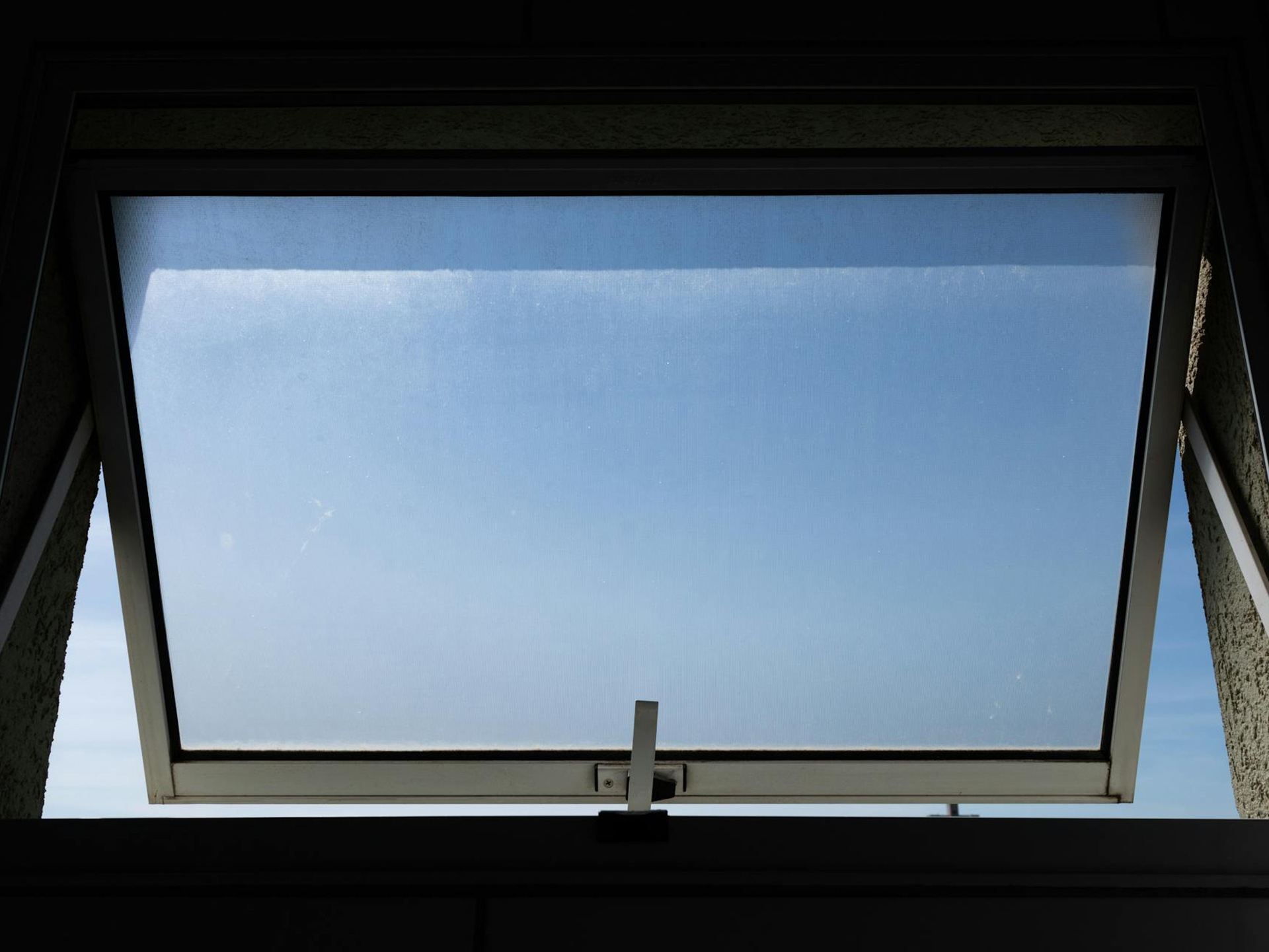
Image credit: Pexels/Athena
If you feel the air is becoming stuffy, the best thing to do is open a window. Carbon dioxide monitors are available, which you can use to check on levels in your home: the aim is to stay below 1000 parts per million (ppm). On its own, carbon dioxide is not the most dangerous gas in terms of indoor pollution. But raised levels when cooking can be a likely indicator of high levels of NO2 and particulate matter.
Particulates
According to the Department of Health, particulate matter (PM) is, “everything in the air that is not a gas and, as such, it is made up from a huge variety of chemical compounds and materials, some of which are toxic. Due to the small size of many of the particles that form PM, some of these toxins may enter the bloodstream and be transported around the body, entering the heart, brain and other organs. Therefore, exposure to PM can result in serious impacts on health, especially in vulnerable groups of people such as the young, elderly and those with respiratory problems.”
PM is classified according to how small it is: PM10 are particles less than 10 micrometres in diameter and PM2.5 are less than 2.5 micrometres in diameter. It’s important to note that particulate pollution levels outdoors have decreased significantly since the 1970s.
Multiple sources of particulate matter indoors include household dust, cooking, candles, and cleaning sprays. Increasing ventilation and using an air purifier can reduce the effects.
Burning wood can be a source of PM, with open fires the worst. Log burners improve things, and it’s best to have a modern Ecodesign Defra exempt (approved) wood burner, which will burn your wood more cleanly. Log burners that meet level 4 or 5 of the Stove Industry Alliance’s Clear Skies Mark scheme are cleaner still. A stove should be installed by a professional and always used according to the manufacturer’s instructions. Annual servicing, regular ash removal and yearly chimney sweeping are essential.
It’s important to only use Ready to Burn fuel that contains less moisture, and therefore generates less smoke. If you season wood at home, you should check it with a wood moisture sensor and make sure that the moisture content is 20% or less before you burn. You can read more about making your log burner more efficient.
Humidity
Another big issue when it comes to indoor air quality is humidity. This is a problem that has got worse as our homes have become better insulated and more airtight, leaving the moisture generated by daily living trapped inside. Raised humidity levels indoors can lead to condensation and the growth of mould and dust mites.
Mould spores in the air aren’t a problem for most people in small quantities. But they can cause respiratory symptoms for some people: those with sensitivity to them, small children, and anyone with a weakened immune system. And, in large quantities, spores can cause respiratory irritation for anyone. So, if you have mould in your home, you need to remove it and try to prevent it from coming back.
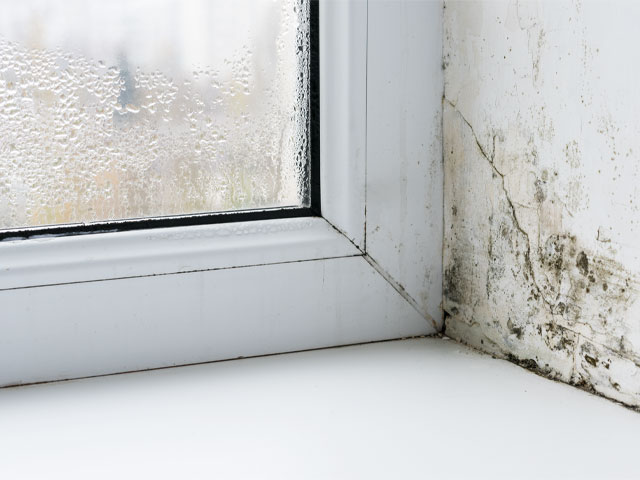
Image credit: Photo: Adobe / andrei310
Solutions to condensation range from simple behaviour changes to built-in solutions. Ways to cut down on the amount of humidity in your home include:
- drying your clothes outdoors, if possible
- putting lids on pans when boiling them
- closing the bathroom door when you have a shower
- squeegeeing water off the shower panels, and reducing the temperature of your shower
- using extractor fans when cooking or using the bathroom
- remembering to open the trickle vents in your windows
You should aim to keep the relative humidity level in your home at 50 to 60%. You can buy a hygrometer to keep a check on it. Find more about how to reduce reduce condensation in your home and how to maintain humidity at the right levels.
Open the windows
Opening your windows is, of course, the ultimate low-fi way to ventilate your property. It’s a great way to reduce humidity if you don’t have a finely balanced mechanical ventilation system. Of course, in winter, you will be letting out warm air you have paid to heat, but there will be times when you just have to bite this bullet.
Opening your windows is also good idea if you’re doing anything likely to generate VOCs, noxious gases or particulates. Just remember to take account of what’s going on outside. For example, if it’s really humid outside, opening a window won’t reduce the humidity in your home. Similarly, if you live near a busy main road, you could just let in lots of air pollution if you open your windows during rush hour. You can check air pollution here on Defra’s interactive pollution map. If hay fever is an issue, remember pollen levels are lowest at dawn and in the late afternoon and evening. So, in pollen season, open your windows then.
Dehumidifiers
Dehumidifiers are a sensible option for dealing with humidity if you don’t want to go to the expense of installing a mechanical ventilation system. Many people find them very useful to deal with humidity in particular spots in the house, a particularly damp room, say, or a room where they are drying clothes.
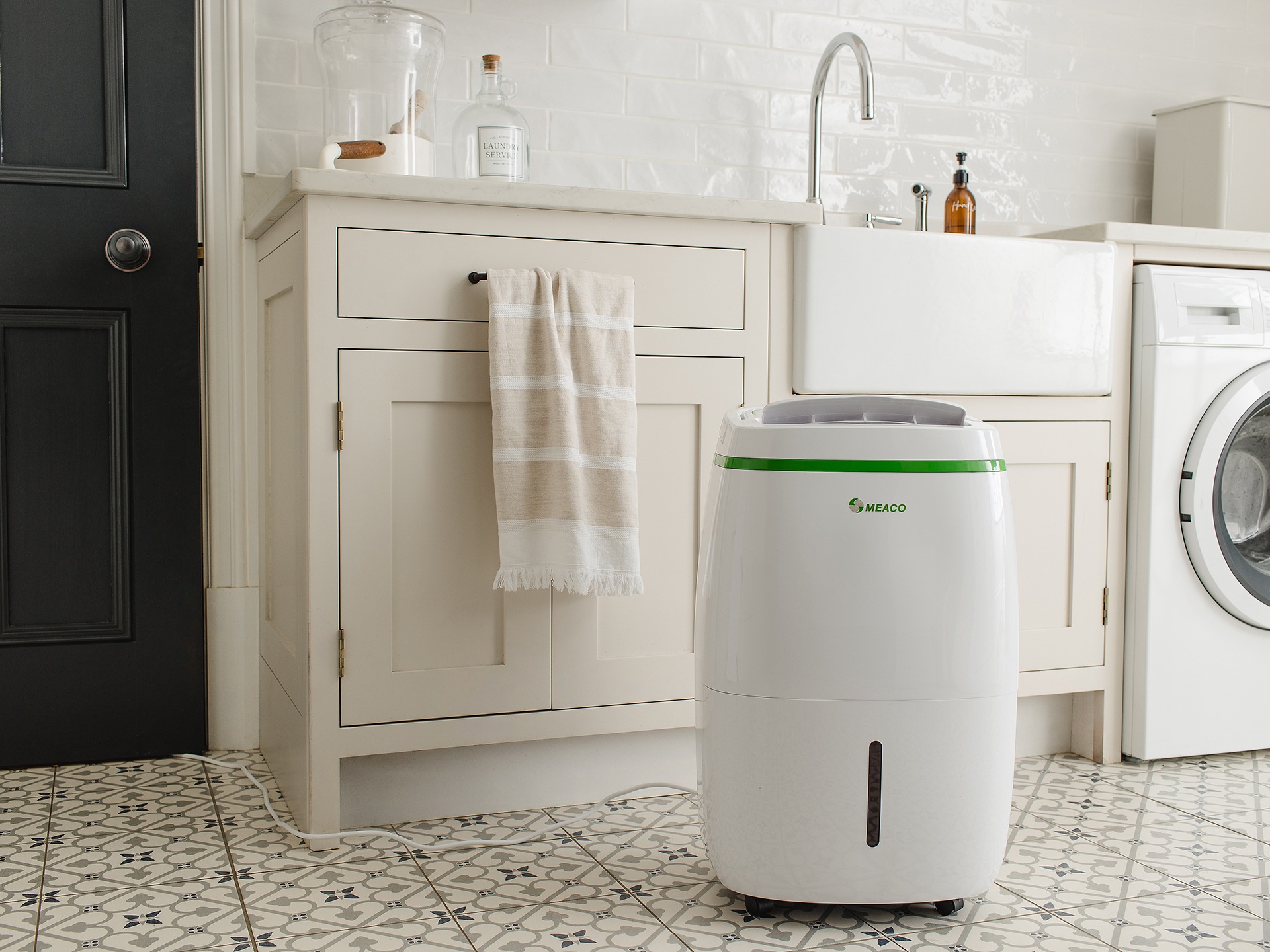
Image credit: Meaco
Chris Michael, from dehumidifier makers Meaco, says, “Dehumidifiers are appliances that remove excessive moisture and humidity in the air. It will reduce the level of humidity in the air, by sucking in air from the room, removing the moisture, and then blowing it back out into the room again, adding warmth in the process. It protects the fabric of the home and the health of its occupants by preventing damp and mould.”
As for a more long-term, engineered solution, you are looking at installing a whole-house ventilation system. There are two main options: positive input ventilation (PIV) and mechanical ventilation with heat reclaim (MVHR). Both systems don’t just deal with humidity, but are great ways to tackle many of the air-quality issues we’re talking about here.
Positive input ventilation
Positive Input Ventilation (PIV) uses an air pump, usually installed in the loft, with a vent going down into the house. It draws fresh into the house through the loft and filters it before pumping it out through a diffuser into the house, usually in the ceiling of the upstairs hallway. As the PIV system pushes fresh air into the house, stale, moist air gets gently pushed out through gaps in the fabric of the building, trickle vents and so on… It’s a relatively easy-to-install system that often works well as a retrofit to reduce condensation problems in old houses.
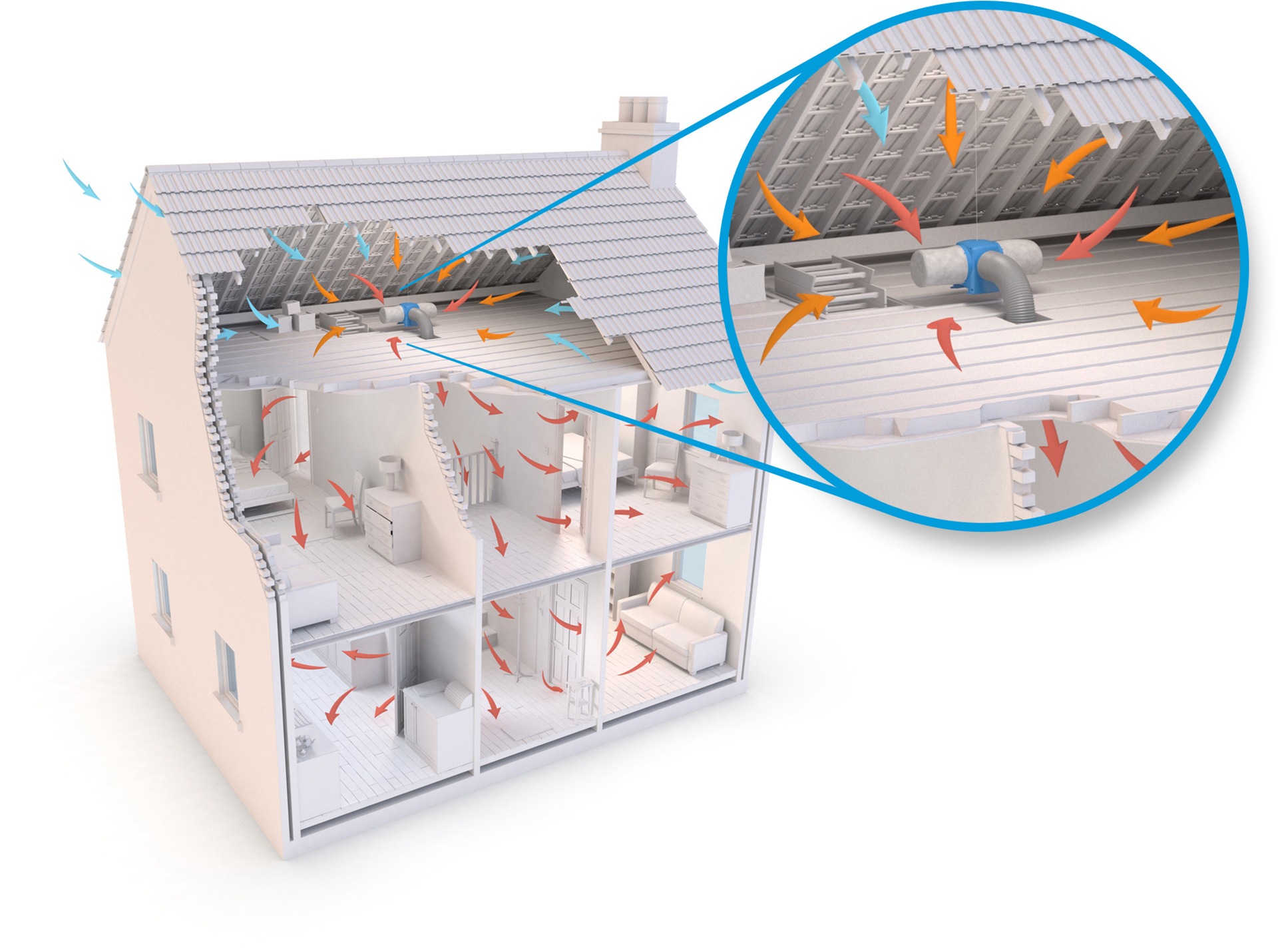
Image credit: Nuaire
MVHR
If you’re embarking on a new build, you might be better off going for a full MVHR system. MVHR ventilation systems are great in well insulated new homes, which tend to be very airtight and have little natural ventilation. MHVR consists of a fan and heat exchanger unit – often sited in the loft – plus an extensive network of ducts leading to vents in each room in the house. Stale, damp air is drawn out of ‘wet’ rooms, like bathrooms and kitchen, and into the unit. There, the heat is extracted from the damp air using a heat exchanger. And the heat is used to warm fresh, filtered air that is simultaneously being drawn into the house through a vent in the roof. The warmed fresh air is then pumped down into the ‘dry’ rooms of the house such as the living room and bedrooms. Meanwhile, the now cool, damp stale air is let out through a separate exhaust outlet in the roof. Air circulates around the house in this manner. You can look at the benefits of MVHR vs PIV. MVHR is less suited to older properties because it requires lots of ducting, which can easily be built into a new home, but is harder to accommodate in a retrofit.
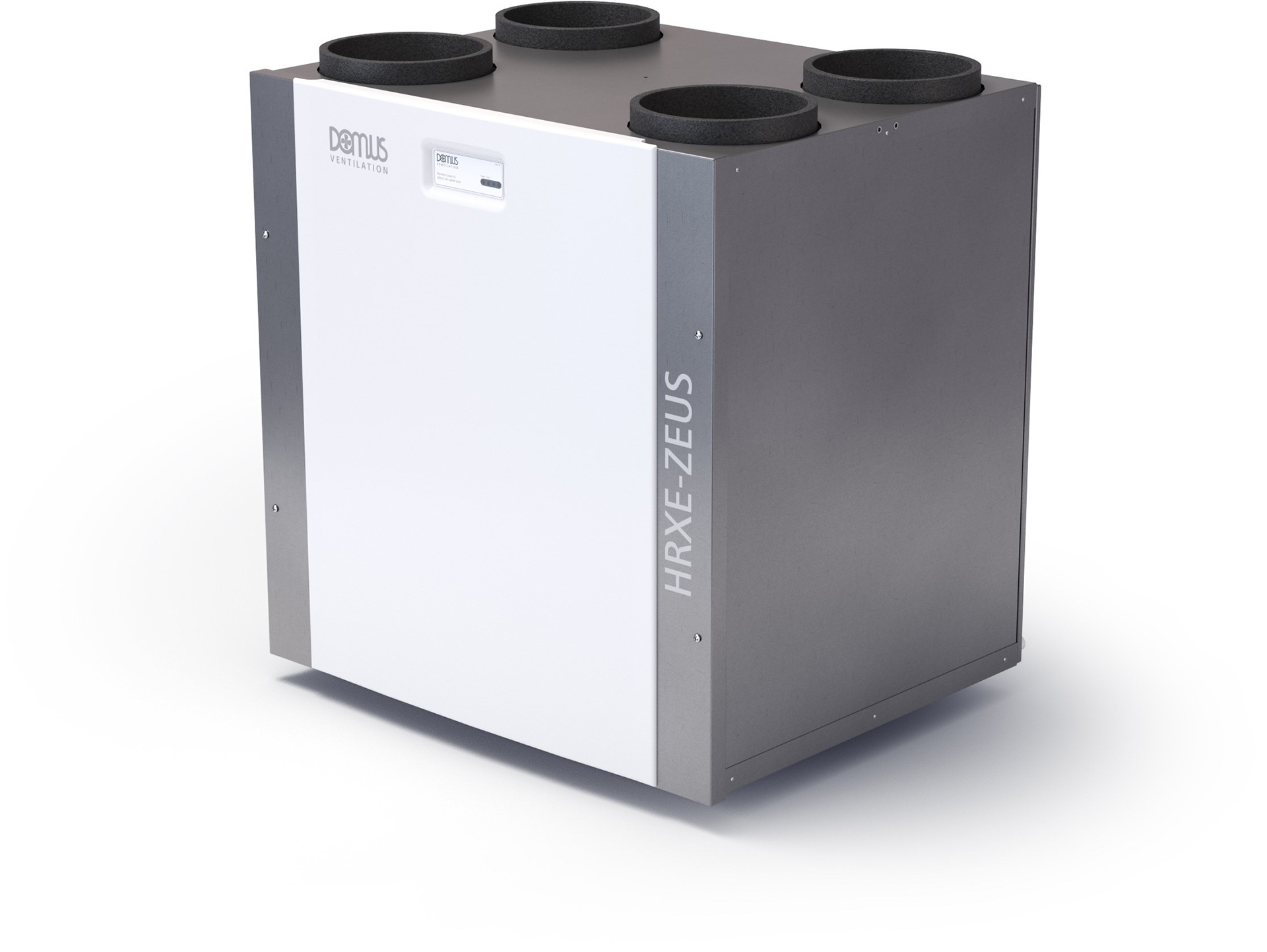
Image credit: Nuaire
Although they are expensive to install, mechanical ventilation systems like PIV and MVHR are ultimately the best way to achieve a sustained improvement in indoor air quality.
Radon
Radon is a colourless and odourless radioactive gas that is generated by the decay of the small amounts of uranium that occur naturally in all rocks and soils. Radon build-up inside your house can be a problem if it is built on rock that releases high levels of radon, as long-term exposure to high levels of radon can lead to lung cancer.
But there are relatively simple fixes. The UK Health Security Agency has a site full of advice about how to reduce the amount of radon in your house if you live in a radon area and find that your home contains high levels. Options include a radon sump underneath the floor of your house, positive input ventilation, and underfloor ventilation. The site contains a map showing where radon-affected areas are, and you can also order radon test kits there to measure levels of the gas in your home.
Other sources of poor air quality
There are other causes of poor indoor air quality to consider too, including:

Image credit: Pexels/Saqi Jugno
- candles: give off particulates into the air as they burn. In fact, the toxins from paraffin candles are the same as those in diesel fumes. So if you love your candles, the advice is: use them in moderation, open a window, and choose more expensive brands
- smoking and vaping: one cause of recent improvement in indoor air quality is the reduction in the number of smokers. (The proportion of the adult population that smokes has reduced from about half in 1974, when records began, to approx 13% now.) This has had a massively positive impact on indoor air quality. Vaping, of course, is a new potential source of concern. There’s a good piece here from Healthline about the effects of second-hand vaping, and how to reduce potential issues. Bottom line is:
– vape outside when possible
– don’t vape around children, anyone who’s pregnant, or anyone with any sort of lung condition
– lower heat and lower power vapes are less harmful,
– avoid flavoured vapes - pets: pet dander – the little bits of dead skin shed by animals – can be an asthma trigger for some people. If this is the case in your family, there are things you can do:
– consider not having pets sleeping in the bedroom
– clean soft-furnishings frequently
– vacuum when allergy-sufferers are out of the house.
Air purifiers
The best way to keep the air in your home clean is to remove the sources of particulates, VOCs and other unpleasant gases, rather than relying on air purifiers to remove them once they are in the air. But air purifiers can reduce dust, pollen, smoke and even viruses. You just need to do your research when buying them, and remember to change/clean the filters.
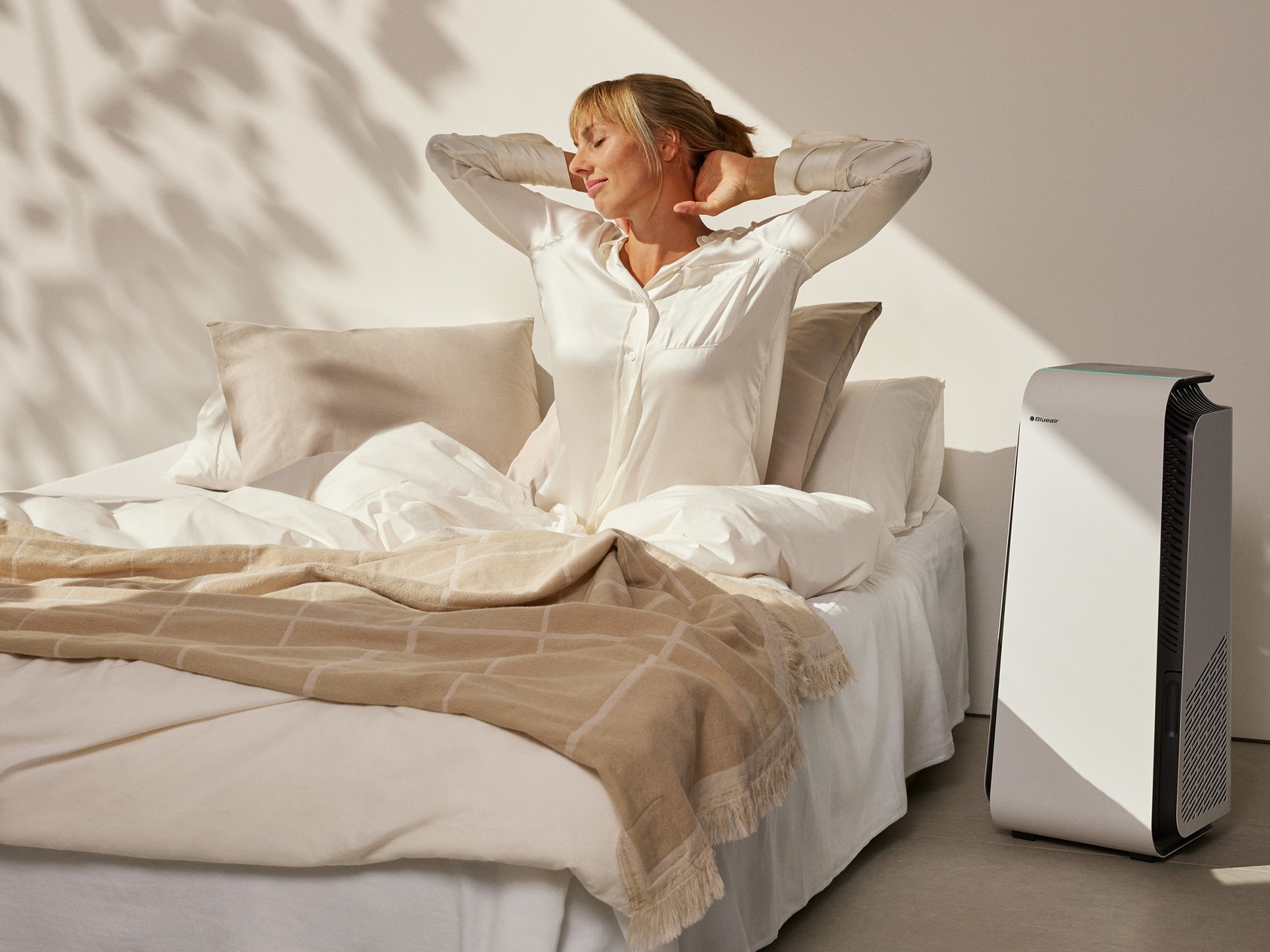
Image credit: Blueair
When choosing an air purifier:
- look at its efficiency (or removal) rate: this is a percentage that shows how well it collects pollutants
- check how much air it draws in ie its air circulation rate: you want a machine that combines a high efficiency rate with a high circulation rate, and that is powerful enough for the size of room you want to place it in. Each model of purifier has a maximum room size it can cope with
- make sure it has a HEPA (High Efficiency Particulate Air) filter (not just HEPA-style or HEPA-type filters). A HEPA filter will remove 99.95% of particles 0.3 microns in size
- remember HEPA filters don’t remove gases or odours though. For those you need a purifier that also has an activated charcoal (carbon) filter.
Be strategic about purchasing and placing air purifiers, and remember that it’s better to remove the sources of pollution. Improve the efficiency of an air purifier by closing the doors and windows of the room it is in.
What about plants?
There is an urban myth that plants will improve the air quality in your home. But currently there is little empirical evidence to back up the idea that house plants will improve air quality in real homes. In fact, if you tend to overwater, they can actually contribute to poor air quality indoors by adding humidity.
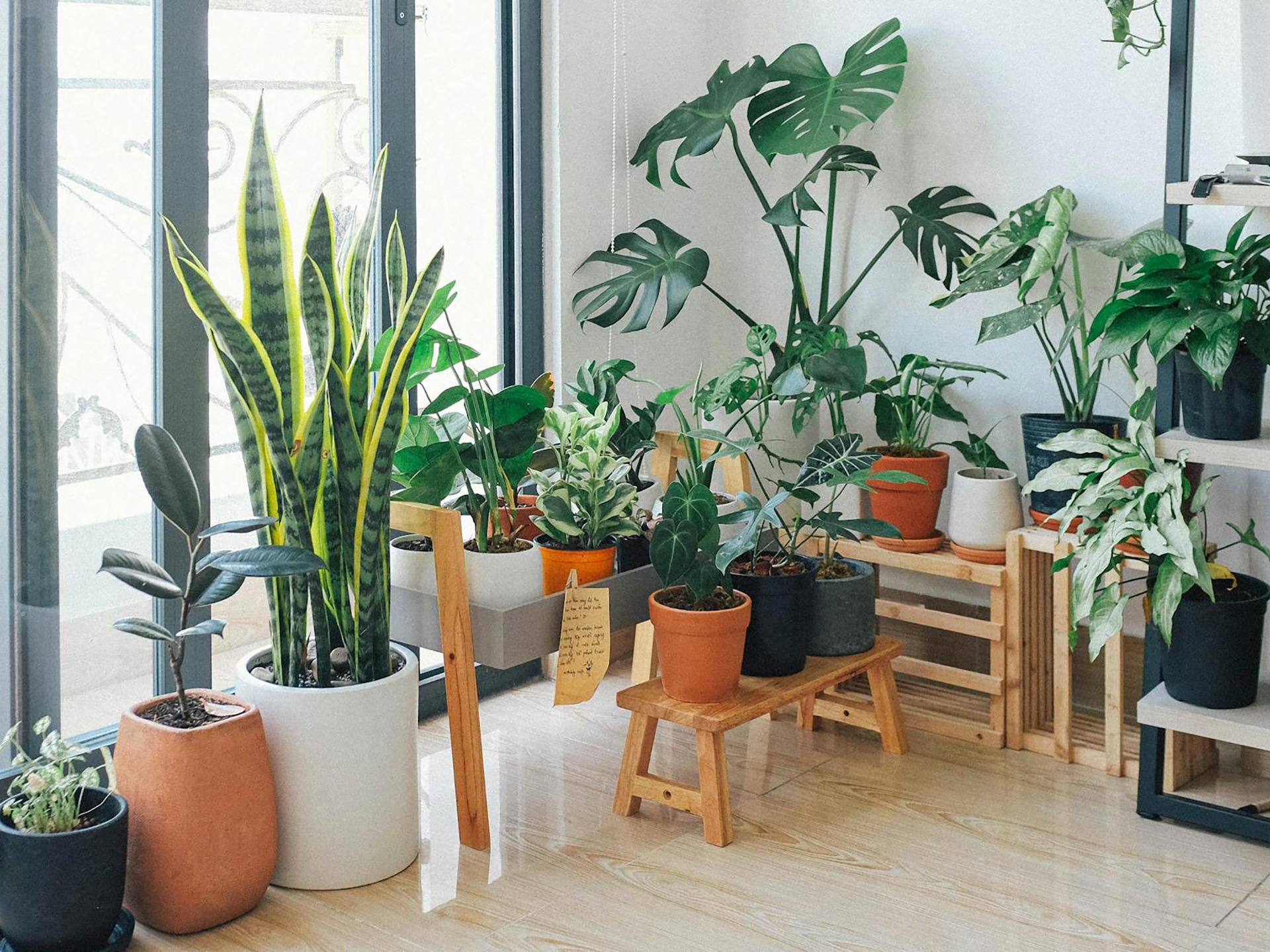
Image credit: Pexels/Huy Phan
Global context
It’s important to keep things in perspective. When we look at the World in Data’s figures for indoor air pollution, we can see that the most serious problems with indoor air pollution lie in countries where people still have to use solid fuels like crop waste, dung, charcoal and coal for cooking and heating in their homes. Burning these on open fires indoors produces both huge quantities of PM and noxious gases.
It is these places, primarily in sub-Saharan Africa and Asia, that account for the vast majority of the four percent of annual global deaths that are attributable to indoor air pollution. World in Data puts it like this, “The issue of indoor air pollution therefore has a clear economic split: it is a problem that has almost been entirely eliminated across high-income countries, but remains a large environmental and health problem at lower incomes.”
So, while we should take the issue of our own indoor air quality seriously, it doesn’t do any harm to remember how relatively lucky we are.
[1] McDaniel D, Farris P, Valacchi G. Atmospheric skin aging-Contributors and inhibitors. J Cosmet Dermatol. 2018;17(2):124‐137. doi:10.1111/jocd.12518
[2] https://www.nature.com/articles/s41598-017-15295-8
[3] https://pubmed.ncbi.nlm.nih.gov/25849769/
[4] https://pubmed.ncbi.nlm.nih.gov/22123373/
[5] According to a YouGov survey looking into global perceptions of air quality, commissioned by Blueair

